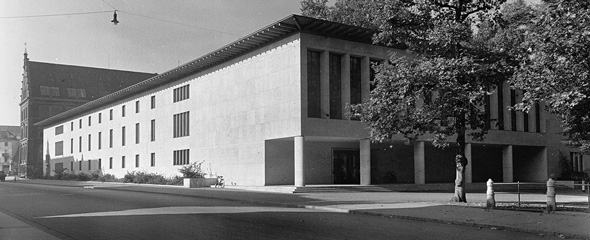The Kollegienhaus
Since its grand opening in 1939, the Kollegienhaus at no. 1 on St. Peter’s Square has been the University of Basel’s central building.
The building, designed by Roland Rohn, was constructed between 1937 and 1939, following decades of discussions, as a replacement for the Lower College on the Rheinsprung, which many felt no longer met the university’s needs. One significant point in these debates was the Old Arsenal building, as the Kollegienhaus’s constructing would require its demolition – a measure approved by a public vote in 1936. Many factors spoke in favor of St. Peter’s Square as the new location, especially its proximity to other newly established university buildings, such as the Bernoullianum (1874), the Vesalianum (1884), the trade school (a building now partly used by the university), and the Museum of Applied Arts, or Gewerbemuseum (1893), with the University Library (1896) and the Botanical Institute (1898).
After more than sixty years of intensive use, the Kollegienhaus was extensively renovated in 2001–2003. Today, the building hosts lectures, presentations, and conferences, while also housing some of the university administration. Situated close to the cafeteria, the University Library, and the Bernoullianum, it serves as a meeting point for students and provides space for the SKUBA (the Student Body of the University of Basel).
Leaving aside the aesthetic features of the building, it is nevertheless worth citing the inscription adorning the walls to the entrance – the opening lines of the university's Founding Charter granted by Pope Pius II, dated 12 November 1459: “Among the many rich blessings which God’s gift allows mortal men to achieve in this fleeting life, not the least is the ability to attain the pearl of knowledge through diligent study. Such a jewel shows the way to a good and happy life and ensures, through its excellence, that those with its wisdom far outshine those without.”
Over the past sixty years, thousands of university members have passed by this inscription. In 1989, the university celebrated the fiftieth anniversary of its new architectural home. At the celebration, Rector Carl Rudolf Pfalz interpreted the year 1939 as a historical turning point: the university, he argued, had dared to make the leap from a small to a medium-sized institution, while preserving the beneficial cohesion of its manageable scale and avoiding the anonymity of a very large university educating masses of students.



